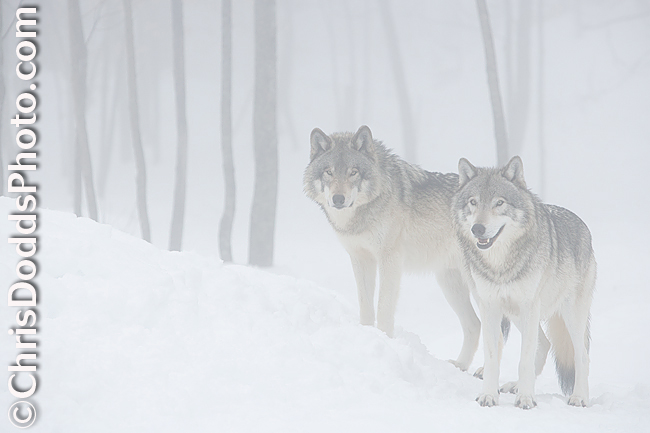 Timber Wolves Alpha Pair in Fog (Grey Wolves, Canis lupus, Loup Gris) Quebec (C) ©Christopher Dodds www.chrisdoddsphoto.com All Rights Reserved. Canon EOS 1DsMKII, 70-200mm F2.8 IS @ 200mm ISO 500, F5.6 1/200s Manual Mode. Hand Held. Full Frame. CLICK HERE TO BUY A PRINT OR LICENSE IMAGE FOR PUBLICATION.
Timber Wolves Alpha Pair in Fog (Grey Wolves, Canis lupus, Loup Gris) Quebec (C) ©Christopher Dodds www.chrisdoddsphoto.com All Rights Reserved. Canon EOS 1DsMKII, 70-200mm F2.8 IS @ 200mm ISO 500, F5.6 1/200s Manual Mode. Hand Held. Full Frame. CLICK HERE TO BUY A PRINT OR LICENSE IMAGE FOR PUBLICATION.
Hearing Timber Wolves (Grey Wolves, Canis lupus, Loup Gris) howl while photographing them on a foggy January mourning was a hair raising experience; their reputation as ferocious enemies of man owes more to fiction and folklore than reality, in fact, they go out of their way to avoid contact with humans. Grey Wolves vary in colour from white on the arctic tundra (Arctic Wolves) to grey (Timber Wolves) or black in the forested regions of Northern wilderness regions. They travel in packs, working co-operatively to bring down their prey; big game like deer, caribou and moose. Most regard wolves as unbeatable hunters, but they often fail to catch their intended prey.
If I had to name a single way for anyone to improve their skill at wildlife photography, it would be to know your subject inside and out. I love to read, and I love books, so I was recently thrilled to get my hands on two simply outstanding books. I've caught myself getting lost in the pages of these marvels of the wild world far too often. Essential for the library of any nature photographer (or nature lover), The Princeton Encyclopedia of Birds and The Princeton Encyclopedia of Mammals have become the go to resource when I'm researching a specific species; or simply sitting here daydreaming of my next big adventure to some far corner of the world. Of all the natural history books in my collection, these two stand out amongst the best! ... and they are a bargain!
The Princeton Encyclopedia of Mammals
(David W. Macdonald ISBN13: 978-0-691-14069-8) is the most comprehensive and accessible reference book on mammals available. Unsurpassed in scope and stunningly illustrated, this book covers every known living species, from aardvarks to zorros. The informative and lively text is written by acclaimed researchers from around the world and features a concise general introduction to mammals followed by detailed accounts of species and groups that systematically describe form, distribution, behavior, status, conservation, and more. There are superb full-color photos and illustrations on virtually every page that show the animals in their natural settings and highlight their typical behaviors. And throughout the book, numerous "Factfile" panels with color distribution maps and scale drawings provide at-a-glance overviews of key data. The Princeton Encyclopedia of Mammals is the definitive one-volume resource--a must-have reference book for naturalists and a delight for general readers.
- Covers every living mammal
- Describes form, distribution, behavior, status, conservation, and more
- Features spectacular full-color photos and illustrations on virtually every page
- Includes "Factfile" panels with color distribution maps and scale drawings for at-a-glance reference
- Written by an international team of experts
David W. Macdonald is director of the Wildlife Conservation Research Unit and a fellow of Lady Margaret Hall at the University of Oxford. He is an award-winning documentary filmmaker and the author of several books, including Mammals of Europe (Princeton).
The Princeton Encyclopedia of Birds
(Christopher Perrins ISBN13: 978-0-691-14070-4) is a comprehensive and lavishly illustrated reference to the world's birds. Accessibly written by renowned biologists and conservationists, and illustrated in color throughout, the book provides authoritative and systematic accounts of every bird family, covering form and function, distribution, diet, social behavior, breeding biology, and conservation and status. More than 1,000 superb color photos reveal the enormous diversity of birds in their natural habitats, from arctic tundra to tropical rain forest, and a wealth of beautifully detailed color and line illustrations depict representative species from each family and highlight characteristic behaviors. The main articles are complemented by detailed coverage of special topics, such as how ibises and spoonbills feed by touch, how pigeons find their way home, and how crows store food. And throughout the book, numerous "Factfile" panels with color distribution maps and scale drawings provide at-a-glance overviews of key data. The Princeton Encyclopedia of Birds is the definitive one-volume reference--an essential guide for amateur bird enthusiasts and professional ornithologists alike.
- Covers all the bird families of the world
- Describes form and function, distribution, diet, social behavior, breeding biology, and conservation and status
- Features more than 1,000 spectacular color photos and illustrations
- Includes "Factfile" panels with color distribution maps and scale drawings for at-a-glance reference
- Explores special topics in depth
- Written by leading biologists and conservationists
Christopher Perrins is a distinguished ornithologist, the author of many popular and scholarly books on birds, and a fellow of the Royal Society. A former professor of ornithology at the University of Oxford and former director of the Edward Grey Institute of Field Ornithology, he is currently a fellow of Wolfson College, Oxford.